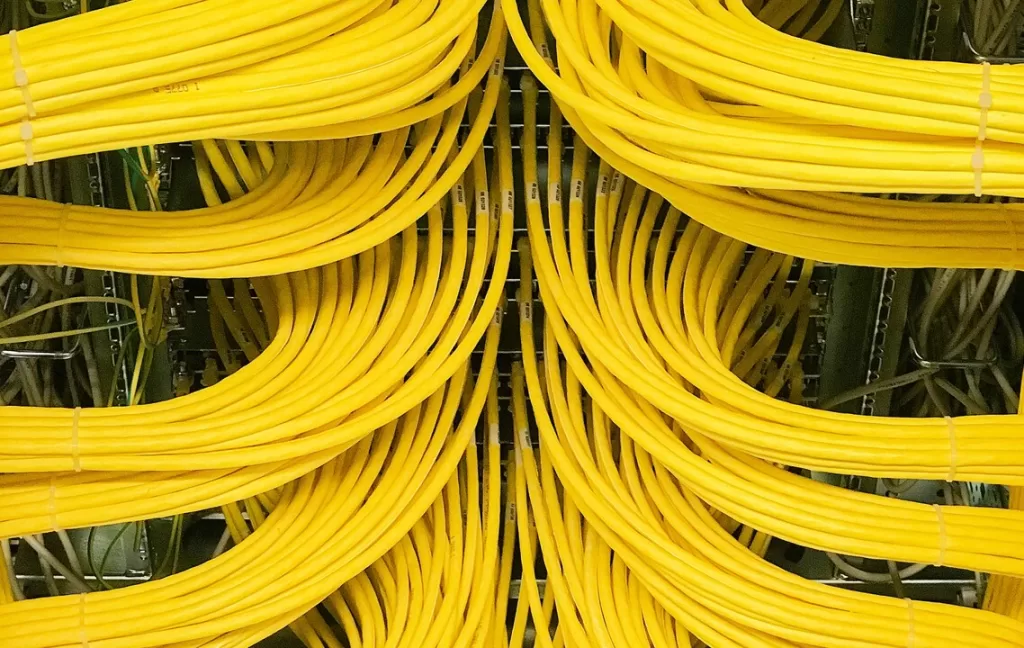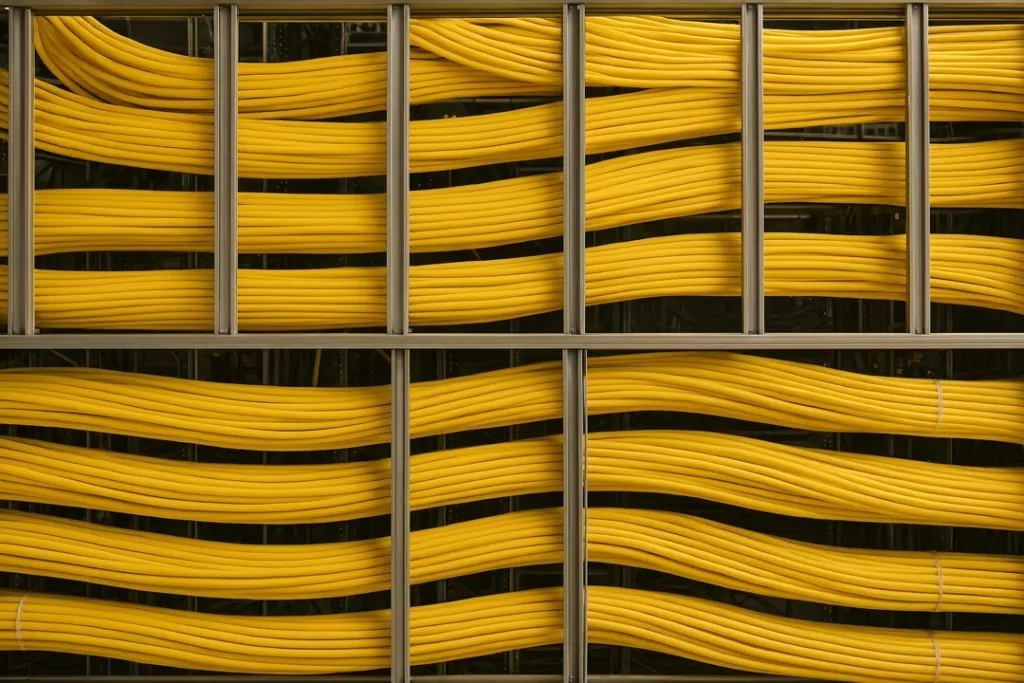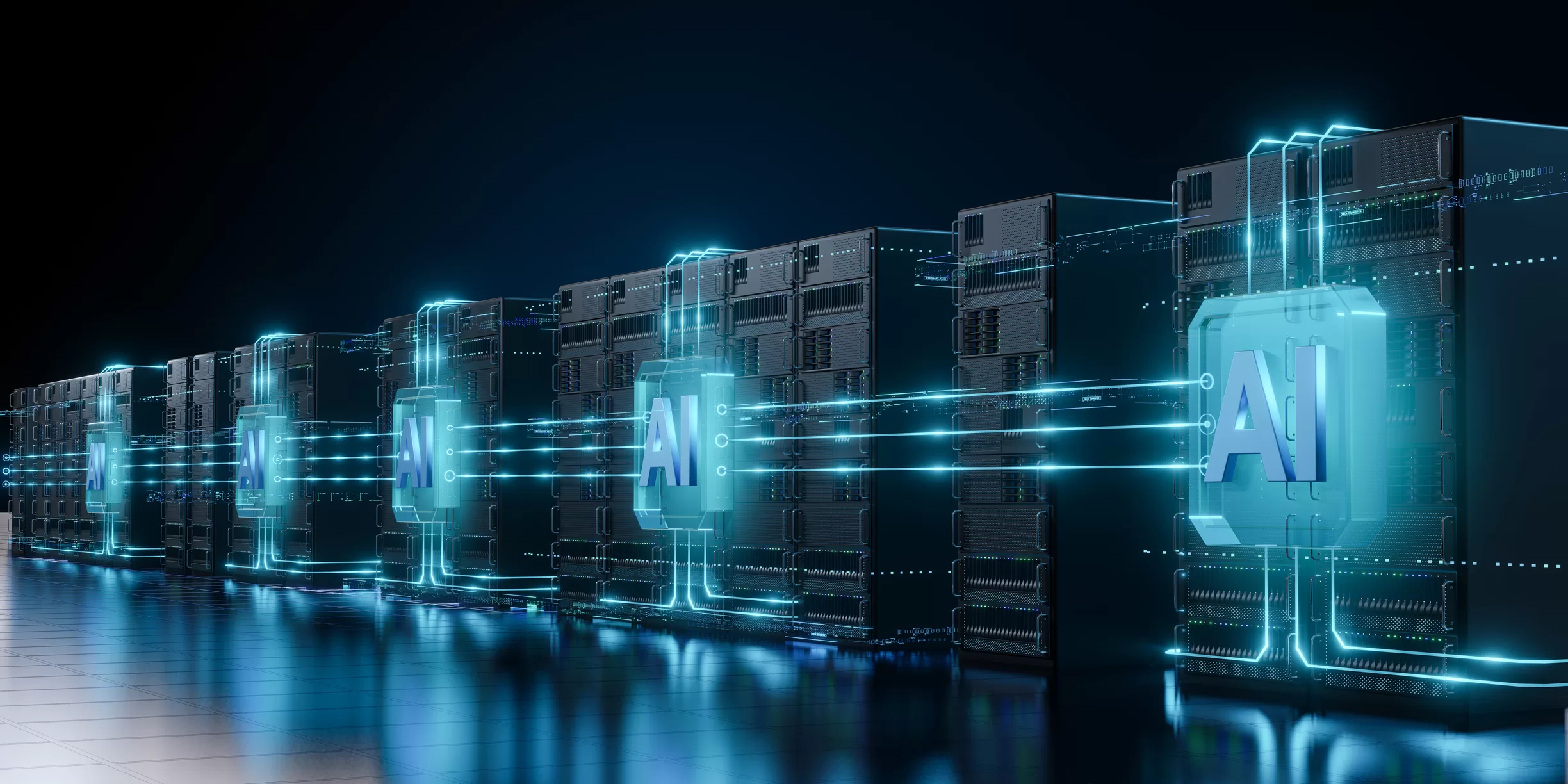The scale of an NVIDIA AI data center is truly breathtaking.
Imagine a campus the size of 20 football fields, its vast footprint dotted with towering server racks and high-capacity cooling units. These facilities—designed to power the future of artificial intelligence and machine learning—can consume 200 megawatts of electricity, the same as a city like Chattanooga, Tennessee. If you stretched the fiber and copper strands in these data centers end to end, they could span 5,000 miles—enough to reach from Los Angeles to New York and back.
NVIDIA’s GPU technology sits at the heart of this transformation, pushing data centers to handle massive workloads requiring ultra-high bandwidth and near-instant response times. It’s like trying to stream thousands of high-definition movies simultaneously without any lag—that’s the kind of performance these AI data centers require.
The challenge of building such complex infrastructure is monumental, but it all begins with smart planning and flawless execution. Here are five essentials for successfully deploying structured cabling in NVIDIA AI data centers:
Step 1: Understand the Demands of AI Workloads
AI workloads using NVIDIA GPUs present an advanced level of data center functionality compared to traditional facilities. The infrastructure of an AI data center enables hundreds of thousands of GPUs to operate in parallel for complex calculations, which requires complete redesigns of cable system deployment and design approaches.
These GPUs rely on extremely fast connections like 400G Ethernet and 800Gb Ethernet interconnects, along with InfiniBand cabling, which necessitate efficient, low-latency cable solutions. The deployment of advanced technologies requires fiber optic cables, which provide minimal signal loss along with strong bandwidth capabilities and quick response times.
AI workload requirements push fiber optic cabling solutions to achieve optimal performance through high-bandwidth optimization. Designers need to understand which cable types work best for linking and powering multiple GPUs operating together through server and storage links and rack density connections.
For more information on how to build and optimize data center infrastructures, explore our Data Center Connectivity Solutions, where we highlight our design and deployment capabilities tailored for high-performance AI-powered data centers.
Action Items:
- Identify and select appropriate fiber optic solutions based on your data center’s AI workloads.
- Implement 400G Ethernet and 800Gb Ethernet connections for high-performance interconnects.
- Prioritize InfiniBand cabling to ensure efficient GPU communication.

Step 2: Implement a High-Performance Structured Cabling Design
The deployment of structured cabling systems in NVIDIA AI data centers requires a sophisticated, high-performance cable design to support today’s demanding needs while also being ready for future growth—similar to building a highway wide enough for today’s traffic and tomorrow’s expected increase.
Advanced Fiber Solutions for AI Performance
The foundational structured cabling components necessary to deliver the performance required for AI workloads are inherently similar to the structured cabling found in any enterprise-class data center. Single-mode fiber is typically used for long-distance connections that link server racks, switches, and storage systems. Multi-mode fiber, on the other hand, is deployed for shorter connections, such as between servers and storage systems within the same rack or between nearby racks.
Where the significant difference lies is in the amount of fiber and copper cabling required — and the massive strand counts that are typically used in NVIDIA AI data centers. Standard fiber cables contain between 144 and 288 strands, enabling the simultaneous operation of multiple high-speed connections. High-capacity NVIDIA backbone connections and data center module connections utilize cables containing up to 1,728 fibers. This high strand count maximizes space utilization and minimizes the physical footprint of high-density cabling infrastructure — essential for the dense, high-performance environments found in these cutting-edge data centers.
High-performance AI and machine learning systems also require specialized transceivers that convert electrical signals into optical signals. The most popular transceivers found in mega data centers operate at 400Gbps speeds using QSFP (Quad Small Form Factor Pluggable) connectors. OSFP transceivers are an excellent solution for high-performance AI workloads because they provide efficient data center module and floor interconnects with high-bandwidth capacity.
Maximizing Data Center Efficiency with MPO/MTP Connectors
Another key element of an effective design is the use of MPO/MTP connectors (Multi-fiber Push-On and Multi-Fiber Termination Push-on). These specialized connectors allow multiple fibers to be connected simultaneously, enabling high-density, high-bandwidth data transfer across data center networks—like organizing multiple highways into one major intersection, reducing clutter, and ensuring smoother traffic flow.
The MPO/MTP connector can unite 144 fibers within a single assembly, optimizing cabling organization while supporting massive data transfers between GPUs, servers, and essential infrastructure components. Fiber-to-fiber connections benefit most from these connectors because they reduce misalignment risks while maintaining system performance.
MPO/MTP connectors provide parallel data transmission through multiple fibers in one connector, resulting in fast data flow while minimizing signal loss. Correct positioning ensures that high-speed AI communication maintains data integrity and delivers peak performance without delays.
Cooling, Redundancy, and Resilience
NVIDIA AI data centers generate a lot of heat due to their dense GPU deployments and power requirements while processing demanding AI functions, so there must be enhanced airflow capabilities to prevent overheating. Proper cable routing ensures efficient cooling of servers and GPUs, based on alternating hot aisle and cold aisle designs. Emerging liquid cooling technologies should be evaluated as alternatives to handle the heat produced by NVIDIA data centers.
A redundant cabling system is also vital. This ensures that data paths are protected and can automatically switch to backup systems in case of a failure, guaranteeing minimal downtime.
For more information on designing structured cabling infrastructure to support high-performance NVIDIA AI workloads, refer to NVIDIA’s Cable Management Guidelines. To learn more about how ServicePoint delivers a full range of structured cabling solutions, visit our Structured Cabling page.
Action Items:
- Implement single-mode and multi-mode fiber solutions for both long- and short-range connections.
- Utilize QSFP (Quad Small Form Factor Pluggable) transceivers for high-speed data transmission.
- Deploy MPO/MTP connectors to support high-density, high-bandwidth data transfer.
- Plan and implement hot/cold aisle designs and redundant cabling systems to enhance system resilience and uptime.

Step 3: Optimize Based on Reference Architectures
Using pre-designed reference architectures is like building from a tried-and-tested blueprint. It simplifies setup, reduces the risk of errors, and ensures that all components meet high standards for AI workloads.
By leveraging modular infrastructure and pre-configured reference designs, data centers can scale more effectively as new systems, such as NVIDIA DGX systems, are introduced. The modular approach allows for more flexible deployment, ensuring that the cabling infrastructure can evolve alongside the growing needs of AI applications.
For instance, NVIDIA’s Scalable Unit (SU) reference design standardizes key components such as compute cabinets, network layouts, and cabling systems. This streamlines the build-out process, reduces setup times, and ensures that your infrastructure can scale without compromising performance.
The SU design also integrates InfiniBand technology, providing ultra-low-latency, high-bandwidth interconnects between GPUs and other components. This is essential for supporting distributed AI training, parallel processing, and other high-performance computing (HPC) workloads. InfiniBand ensures fast, efficient communication, meeting the high-speed, high-volume demands of modern AI applications.
Action Items:
- Integrate reference designs to simplify deployment and ensure scalability.
- Use modular infrastructure to allow for easy scaling as new AI systems are added.
- Adopt NVIDIA DGX systems as a reference to support distributed AI training and high-performance computing (HPC).
Step 4: Ensure Error-Free Transmission with Fiber Polarity Management
Proper fiber polarity management is critical to ensuring that data flows seamlessly across the network. Misaligned polarity can lead to signal degradation, system failures, and unnecessary downtime—especially in AI-driven environments, where consistent, high-speed communication is crucial.
The polarity management process involves choosing the correct fiber polarity schemes (Type A, Type B, or Type C) to ensure proper alignment of fibers and connectors. MPO/MTP connectors with low insertion loss and high return loss are particularly important for ensuring that signals remain strong and reliable.
Type A polarity features a straight-through configuration where each fiber on one end directly corresponds to the same position on the other end. Type B polarity uses a crossover pattern, swapping fibers at one end to ensure proper signal flow. Type C, known for its “key-up to key-down” alignment, ensures connectors are inserted in the correct orientation—making it ideal for high-performance networks like AI data centers. Other schemes such as Type D, Type E, and Type F exist for specialized use cases.
Type C polarity is favored in modern networks, particularly in large-scale deployments with MPO connectors, due to its simplicity and efficiency.
By using the right polarity schemes and ensuring that all connections are aligned correctly, you can maintain the integrity of your data transmission, allowing your AI workloads to perform at peak efficiency.
Action Items:
- Implement fiber polarity management to ensure error-free data transmission.
- Use Type A, Type B, or Type C polarity schemes to meet your data center’s requirements.

Step 5: Prioritize Cable Testing, Management, and Maintenance
Once the cabling infrastructure is in place, it’s essential to prioritize testing, management, and maintenance to ensure long-term performance. Over time, cables can degrade, connectors can become dirty, and environmental factors such as temperature or humidity can impact performance.
Regular testing should include insertion loss testing, return loss testing, and Optical Time Domain Reflectometer (OTDR) testing to identify any issues that might impact signal quality.
Proper cable management ensures that cables remain organized and protected, preventing physical damage and reducing the risk of signal interference. Using tools like vertical cable managers and structured cable raceways can help maintain an organized system that allows for easy access and troubleshooting, protect cables, ensure efficient airflow, and reduce physical damage risks. Proper cable routing optimizes performance and prevents overheating in high-density AI environments.
Finally, regular maintenance extends the lifespan of the infrastructure and ensures continuous operation. Over time, cables may degrade due to wear and tear, connectors may accumulate dust or dirt, and environmental factors like temperature or humidity can affect performance.
Action Items:
- Perform regular testing on all fiber optic and copper cables.
- Schedule routine maintenance to inspect cables, clean connectors, and ensure the overall health of the infrastructure.
- Use structured cable raceways and vertical cable managers to maintain an organized and efficient system.
Conclusion: Building the Future of AI Data Centers
As AI continues to evolve, the need for optimized data centers capable of supporting these workloads will only increase. Building an NVIDIA mega data center is no small feat, but following these five essential steps ensures the infrastructure is designed and executed for success. By deploying fiber optic cabling solutions that support the growing demands of AI, data centers can serve as the backbone for the AI-driven future.
Are you ready to optimize your data center for AI applications? Contact Us today to learn how our data center connectivity solutions can help you build a robust and scalable infrastructure that meets the needs of tomorrow’s AI workloads.


